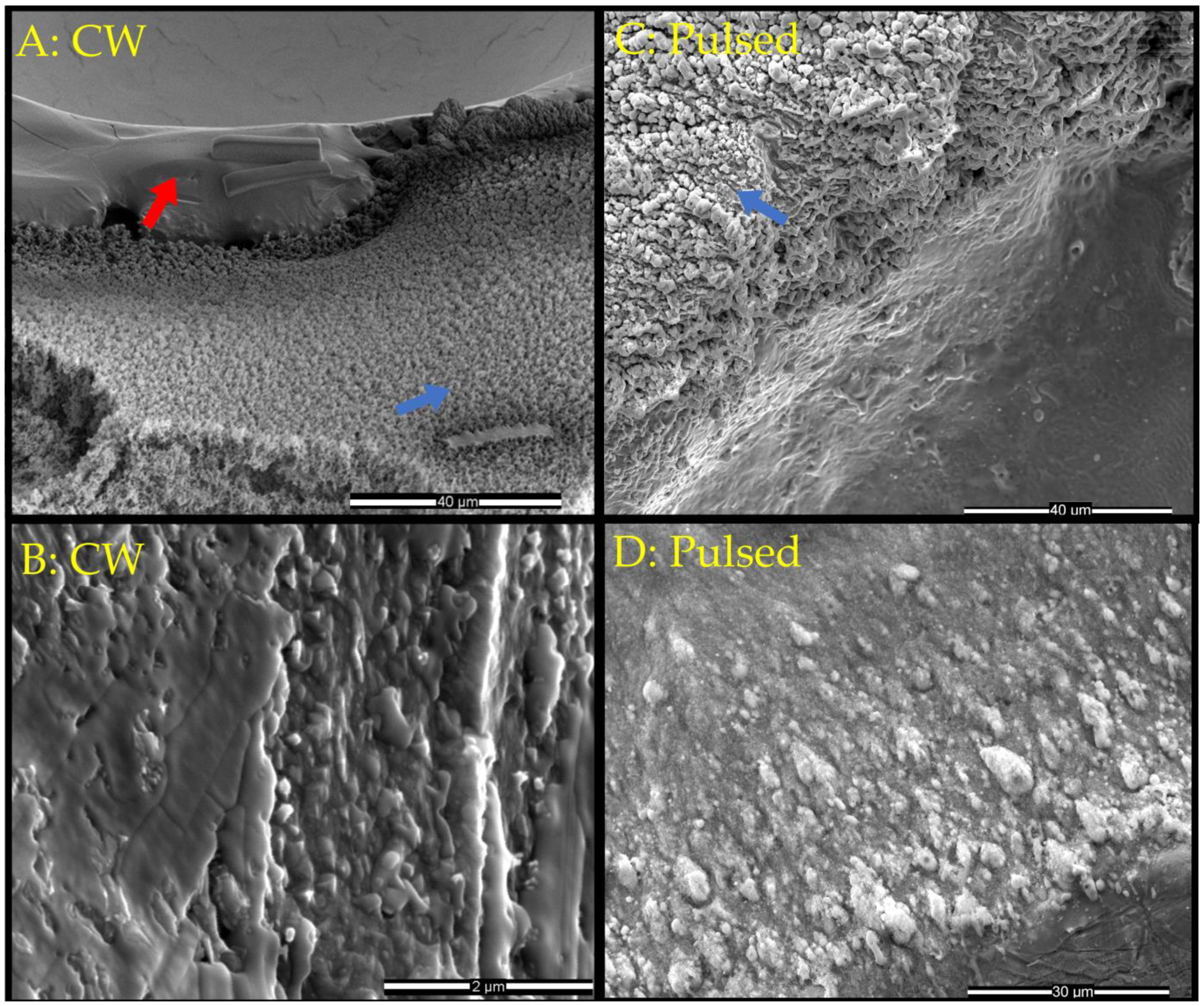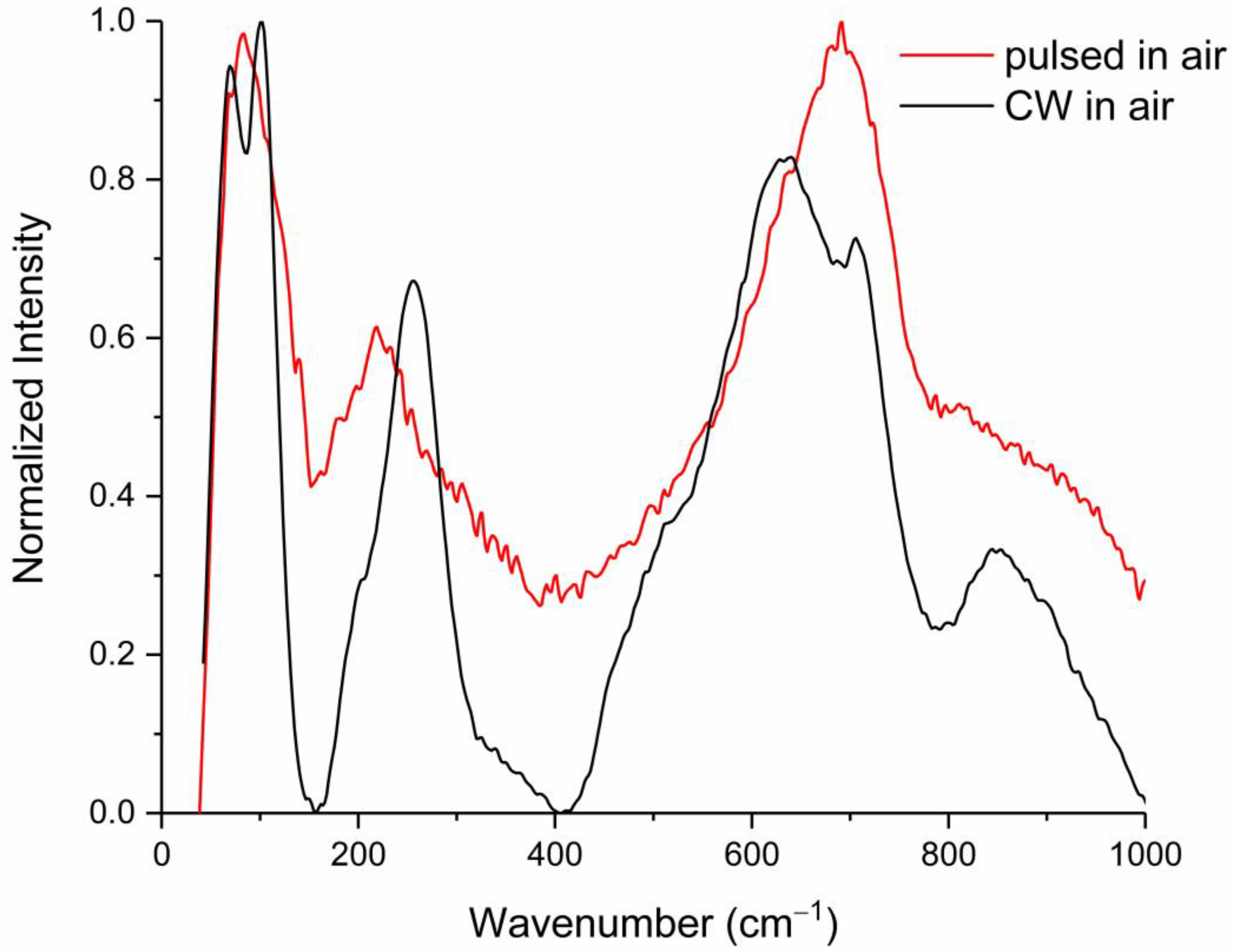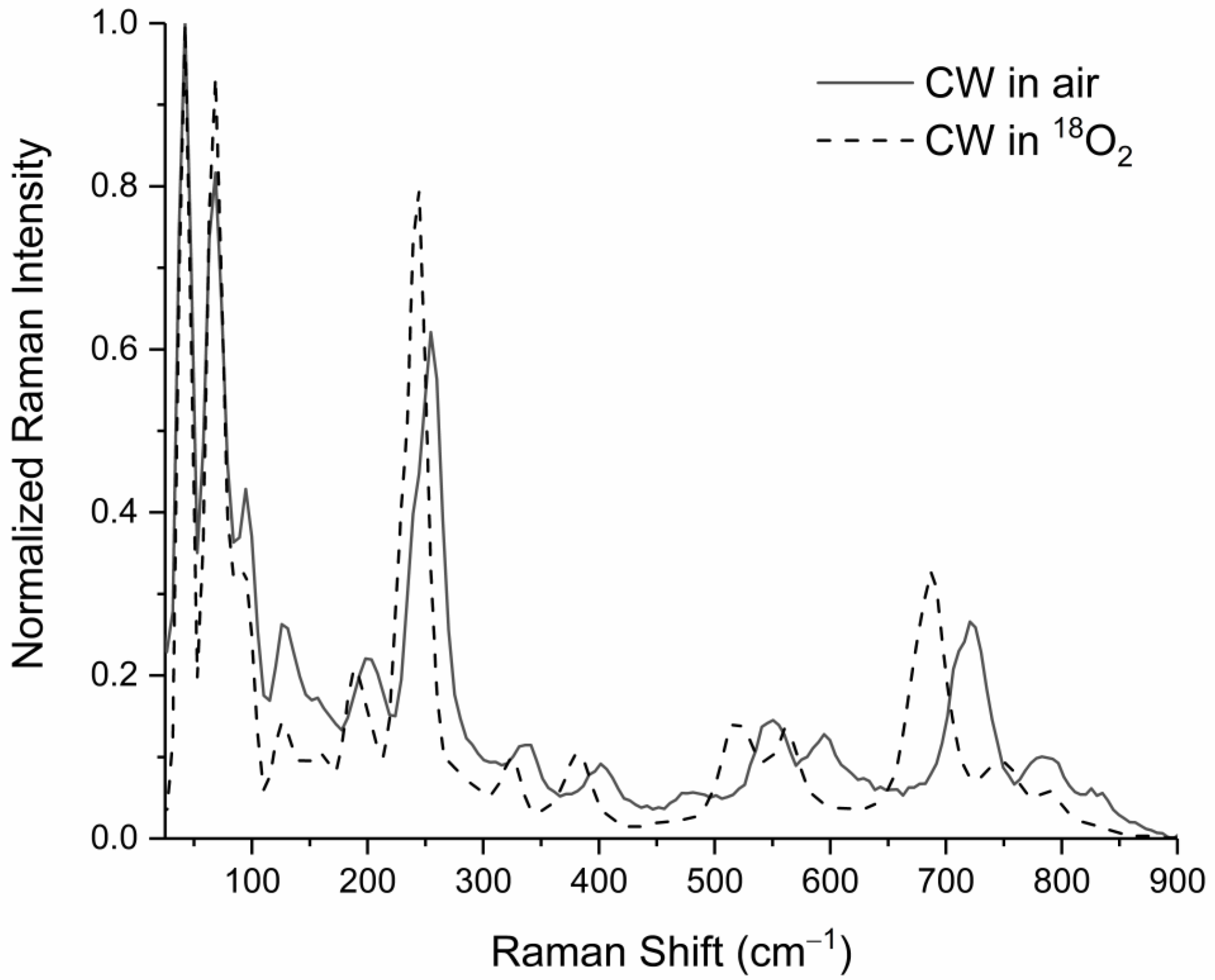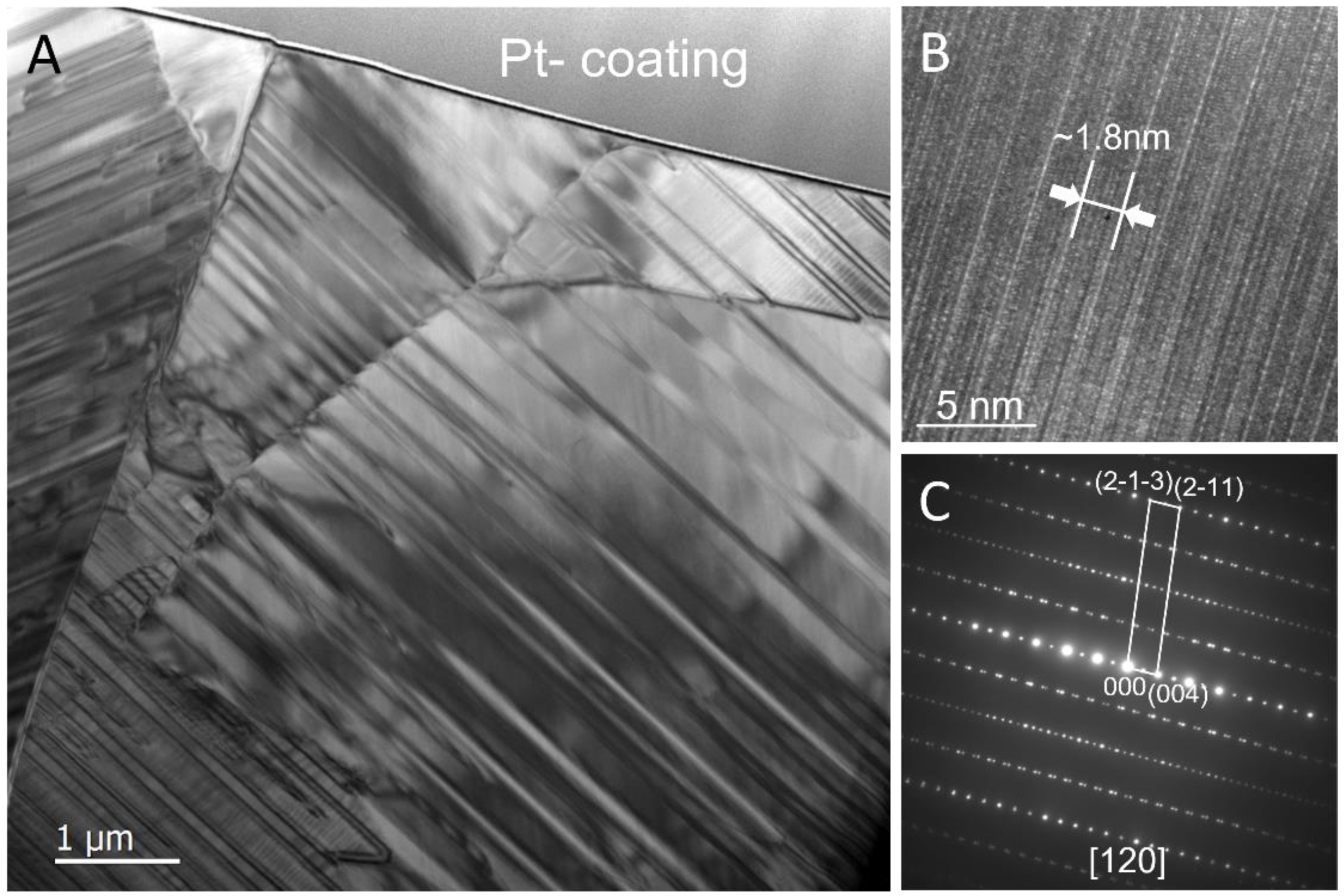An Investigation of Oxides of Tantalum Produced by Pulsed Laser Ablation and Continuous Wave Laser Heating
Abstract
:1. Introduction
2. Materials and Methods
2.1. Experiment Preparation
2.2. Ex Situ Raman Spectroscopy
2.3. Scanning Electron Microscopy
2.4. Transmission Electron Microscopy and Electron Diffraction
3. Results
3.1. SEM Imaging Overview of Tantalum Surface Morphology
3.2. Raman Identification of β-Ta2O5
3.3. Raman Identification of a-Ta2O5
3.4. Raman Spectroscopy of Particles near the Crater of the CW-Heated Tantalum Surface
3.5. TEM and Electron Diffraction Analysis of Particles near the Crater of the CW Heated Tantalum Surface
4. Discussion
5. Conclusions
Supplementary Materials
Author Contributions
Funding
Data Availability Statement
Acknowledgments
Conflicts of Interest
References
- Sathasivam, S.; Williamson, B.A.D.; Kafizas, A.; Althabaiti, S.A.; Obaid, A.Y.; Basahel, S.N.; Scanlon, D.O.; Carmalt, C.J.; Parkin, I.P. Computational and Experimental Study of Ta2O5 Thin Films. J. Phys. Chem. C 2017, 121, 202–210. [Google Scholar] [CrossRef]
- Lin, J.; Masaaki, N.; Tsukune, A.; Yamada, M. Ta2O5 Thin Films with Exceptionally High Dielectric Constant. Appl. Phys. Lett. 1999, 74, 2370–2372. [Google Scholar] [CrossRef]
- Coucheron, D.A.; Wadduwage, D.N.; Murugan, G.S.; So, P.T.C.; Ahluwalia, B.S. Chip-Based Resonance Raman Spectroscopy Using Tantalum Pentoxide Waveguides. IEEE Photonics Technol. Lett. 2019, 31, 1127–1130. [Google Scholar] [CrossRef]
- Dobal, P.S.; Katiyar, R.S.; Jiang, Y.; Guo, R.; Bhalla, A.S. Raman Scattering Study of a Phase Transition in Tantalum Pentoxide. J. Raman Spectrosc. 2000, 31, 1061–1065. [Google Scholar] [CrossRef]
- Cava, R.; Krajewski, J. Dielectric Properties of Ta2O5-ZrO2 Polycrystalline Ceramics. J. Appl. Phys. 1998, 83, 1613. [Google Scholar] [CrossRef]
- Wu, S.J.; Houng, B.; Huang, B. Effect of Growth and Annealing Temperatures on Crystallization of Tantalum Pentoxide Thin Film Prepared by RF Magnetron Sputtering Method. J. Alloys Compd. 2009, 475, 488–493. [Google Scholar] [CrossRef]
- Jeon, S.R.; Han, S.W.; Park, J.W. Effect of Rapid Thermal Annealing Treatment on Electrical Properties and Microstructure of Tantalum Oxide Thin Film Deposited by Plasma-enhanced Chemical Vapor Deposition. J. Appl. Phys. 1995, 77, 5978–5981. [Google Scholar] [CrossRef]
- Moon, H.; Lee, J.S.; Han, S.W.; Park, J.-W.; Lee, J.H.; Yang, S.K.; Park, H. Effect of Deposition Temperature on Dielectric Properties of PECVD Ta2O5 Thin Film. J. Mater. Sci. 1994, 29, 1545–1548. [Google Scholar] [CrossRef]
- Kamiyama, S.; Lesaicherre, P.; Suzuki, H.; Sakai, A.; Nishiyama, I.; Ishitani, A. Ultrathin Tantalum Oxide Capacitor Dielectric Layers Fabricated Using Rapid Thermal Nitridation Prior to Low Pressure Chemical Vapor Deposition. J. Electrochem. Soc. 1993, 140, 1617–1625. [Google Scholar] [CrossRef]
- Chaneliere, C.; Four, S.; Autran, J.L.; Devine, R.A.B. Comparison between the Properties of Amorphous and Crystalline Ta2O5 Thin Films Deposited on Si. Microelectron. Reliab. 1999, 39, 261–268. [Google Scholar] [CrossRef]
- Dimitrova, T.; Arshak, K.; Atanassova, E. Crystallization Effects in Oxygen Annealed Ta2O5 Thin Films on Si. Thin Solid Films 2001, 381, 31–38. [Google Scholar] [CrossRef]
- Lagergren, S.; Magnéli, A. On the Tantalum—Oxygen System. Acta Chem. Scandenavica 1952, 6, 444–446. [Google Scholar] [CrossRef]
- Liu, X.Q.; Han, X.D.; Zhang, Z.; Ji, L.F.; Jiang, Y.J. The Crystal Structure of High Temperature Phase Ta2O5. Acta Mater. 2007, 55, 2385–2396. [Google Scholar] [CrossRef]
- Bali, K.; Nánai, L. Laser Light Induced Oxidation of Tantalum in Air. Spectrochim. Acta Part A Mol. Spectrosc. 1990, 46, 499–502. [Google Scholar] [CrossRef]
- Palatnikov, M.; Shcherbina, O.; Sidorov, N.; Bormanis, K. The Structure of Niobium and Tantalum Oxides Processed by Concentrated Light Flux. Ukr. J. Phys. Opt. 2012, 13, 207–214. [Google Scholar] [CrossRef]
- Palatnikov, M.; Shcherbina, O.; Frolov, A.; Pavlikov, V.; Chufyrev, P.; Makarova, O.; Bormanis, K. Formation of Fractal Micro- and Nano-Structures in Ceramic Tantalum Pentoxide Under Concentrated Flux of Light and Their Effect on Thermal Expansion. Integr. Ferroelectr. 2009, 108, 89–97. [Google Scholar] [CrossRef]
- Joseph, C.; Bourson, P.; Fontana, M.D. Amorphous to Crystalline Transformation in Ta2O5 Studied by Raman Spectroscopy. J. Raman Spectrosc. 2012, 43, 1146–1150. [Google Scholar] [CrossRef]
- Perez, I.; Carrejo, J.L.E.; Sosa, V.; Perera, F.G.; Mancillas, J.R.F.; Galindo, J.T.E.; Rodríguez, C.I.R. Evidence for Structural Transition in Crystalline Tantalum Pentoxide Fi Lms Grown by RF Magnetron Sputtering. J. Alloys Compd. 2017, 712, 303–310. [Google Scholar] [CrossRef]
- Zhu, M.; Zhang, Z.; Miao, W. Intense Photoluminescence from Amorphous Tantalum Oxide Films. Appl. Phys. Lett. 2006, 89, 021915. [Google Scholar] [CrossRef]
- Coillet, E. Structural Characterization of Thin Non-Crystalline Layers for Low Thermal Noise Optic. Ph.D. Thesis, Université de Lyon, Lyon, France, 2017. [Google Scholar]
- Sankur, H.O.; Gunning, W. Deposition of Optical Thin Films by Pulsed Laser Assisted Evaporation. Appl. Opt. 1989, 28, 2806–2808. [Google Scholar] [CrossRef]
- Damart, T.; Coillet, E.; Tanguy, A.; Rodney, D. Numerical Study of the Structural and Vibrational Properties of Amorphous Ta2O5 and TiO2-Doped Ta2O5. J. Appl. Phys. 2016, 119, 175106. [Google Scholar] [CrossRef]
- Weckhuysen, B.M.; Jehng, J.-M.; Wachs, I.E. In Situ Raman Spectroscopy of Supported Transition Metal Oxide Catalysts: 18O2−16O2 Isotopic Labeling Studies. J. Phys. Chem. B 2000, 104, 7382–7387. [Google Scholar] [CrossRef]
- Stephenson, N.C.; Roth, R.S. The Crystal Structure of the High Temperature Form of Ta2O5. J. Solid State Chem. 1971, 3, 145–153. [Google Scholar] [CrossRef]





| Laser Type | Particulate Detected | Atmosphere | Location |
|---|---|---|---|
| Pulsed | β-Ta2O5 | Air and 18O2 | Crater edge |
| a-Ta2O5 | Air | ~1 cm from the crater and on the collection substrate | |
| CW | β-Ta2O5 | Air and 18O2 | ~1 µm-mm from crater edge |
| H-Ta2O5 | Air and 18O2 | Crater edge |
| Peak Assignment (cm−1) | Laser | Description |
|---|---|---|
| 70 | CW and pulsed | cluster |
| 100 | CW | |
| 200 | CW | Deformation O-2Ta and O-3Ta |
| 260 | CW and pulsed | |
| 470 | CW | Stretching triple coordinated oxygen O-3Ta |
| 610 | CW and pulsed | |
| 710 | CW and pulsed | |
| 850 | CW | Stretching double-coordinated oxygen O-2Ta |
Disclaimer/Publisher’s Note: The statements, opinions and data contained in all publications are solely those of the individual author(s) and contributor(s) and not of MDPI and/or the editor(s). MDPI and/or the editor(s) disclaim responsibility for any injury to people or property resulting from any ideas, methods, instructions or products referred to in the content. |
© 2024 by the authors. Licensee MDPI, Basel, Switzerland. This article is an open access article distributed under the terms and conditions of the Creative Commons Attribution (CC BY) license (https://creativecommons.org/licenses/by/4.0/).
Share and Cite
Auner, A.W.; Crowhurst, J.C.; Weisz, D.G.; Dai, Z.; Knight, K.B. An Investigation of Oxides of Tantalum Produced by Pulsed Laser Ablation and Continuous Wave Laser Heating. Materials 2024, 17, 4947. https://doi.org/10.3390/ma17204947
Auner AW, Crowhurst JC, Weisz DG, Dai Z, Knight KB. An Investigation of Oxides of Tantalum Produced by Pulsed Laser Ablation and Continuous Wave Laser Heating. Materials. 2024; 17(20):4947. https://doi.org/10.3390/ma17204947
Chicago/Turabian StyleAuner, Alexander W., Jonathan C. Crowhurst, David G. Weisz, Zurong Dai, and Kimberly B. Knight. 2024. "An Investigation of Oxides of Tantalum Produced by Pulsed Laser Ablation and Continuous Wave Laser Heating" Materials 17, no. 20: 4947. https://doi.org/10.3390/ma17204947







